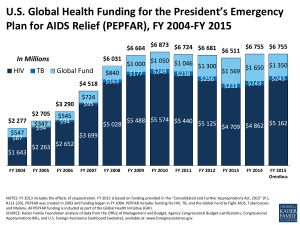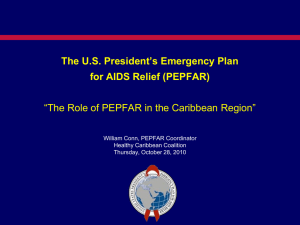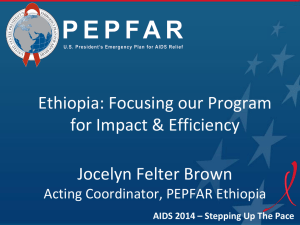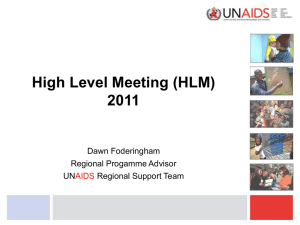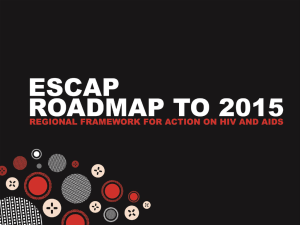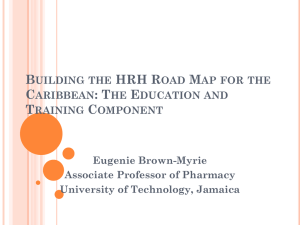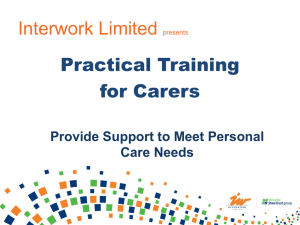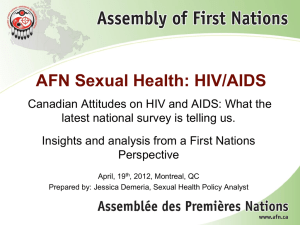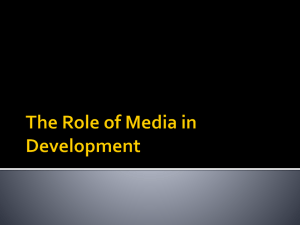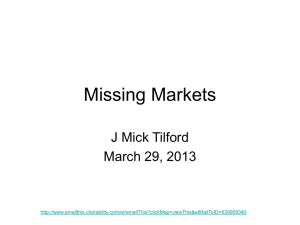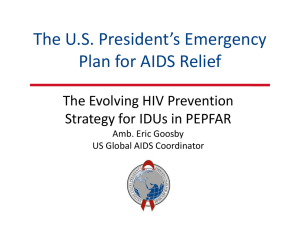USPEPFAR_Partnership Framework_PANCAP_
advertisement
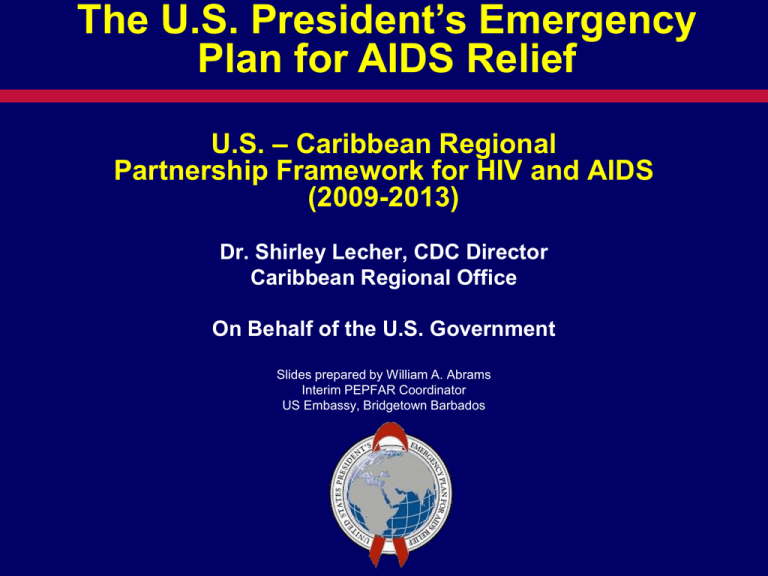
The U.S. President’s Emergency Plan for AIDS Relief U.S. – Caribbean Regional Partnership Framework for HIV and AIDS (2009-2013) Dr. Shirley Lecher, CDC Director Caribbean Regional Office On Behalf of the U.S. Government Slides prepared by William A. Abrams Interim PEPFAR Coordinator US Embassy, Bridgetown Barbados The U.S. President’s Emergency Plan for AIDS Relief (PEPFAR) OVERVIEW • PEPFAR was reauthorized by the U.S. Congress in July 2008 and will represent over 70% of U.S. global health funding as part of the Obama administration’s new six-year, $63 billion Global Health Initiative (2009-2014). • The bulk of PEFPAR funding over the next five years will be used to fight HIV/AIDS ($39 billion) with funds also allocated to fight Malaria ($5 billion) and Tuberculosis ($4 billion). • PEPFAR has set the following 3-12-12 global goals: • Treatment for at least 3 million people living with HIV/AIDS • Prevention of 12 million new HIV infections • Care for 12 million people, including 5 million orphans & vulnerable children. • To meet these goals, PEPFAR will support training of at least 140,000 new health care workers in HIV/AIDS prevention, treatment and care. 2 3 PEPFAR IN THE CARIBBEAN The Reauthorization Act included an increase in funding from the U.S. Government to fight HIV/AIDS in the Caribbean region. The Caribbean region as defined under PEFPAR includes the following 12 countries: • • • • • • Bahamas Barbados Belize Jamaica Trinidad and Tobago Suriname Six Eastern Caribbean states: • Antigua and Barbuda • Dominica • Grenada • St. Kitts and Nevis • St. Lucia • St. Vincent and the Grenadines The Dominican Republic, Guyana and Haiti are not included because all three countries receive direct bilateral USG assistance. 4 USG – Caribbean Partnership Framework • Future USG funding and technical assistance is contingent upon developing a non-binding U.S. - Caribbean Regional Partnership Framework for HIV and AIDS • The vision for the Partnership Framework is to provide a 5-year joint strategic framework for cooperation between the USG, Caribbean governments, and key national, regional and international nongovernmental and civil society organizations to combat HIV/AIDS in the region • PEPFAR funding for these 12 countries has increased from $8 million in 2004 to over $23+ million in the 1st year of the Partnership Framework • This $15 million increase in funds will be programmed during the 1st year of the Partnership Framework (2009 – 2010) • Though future funding is contingent upon completion of the Partnership Framework and annual appropriations by the U.S. Congress, the Caribbean region will hopefully receive level HIV/AIDS funding & technical assistance over the next five years 5 The U.S. President’s Emergency Plan for AIDS Relief One USG Approach The following U.S. Government agencies work in a coordinated fashion with host governments and key partners in the Caribbean region to implement PEPFAR: • Department of State • Agency for International Development (USAID) • Department of Health and Human Services (HHS) • Centers for Disease Control & Prevention (CDC) • Health Resources and Services Administration (HRSA) • Department of Defense • Peace Corps 6 Partnership Framework Structure Partnership Framework documents consist of two parts: – Partnership Framework – Partnership Framework Implementation Plan Partnership Framework broadly lays out: – – – – – – – – Background Purpose Partners, roles and commitments Principles 5-year strategic overview Plans for developing the Implementation Plan Management and communications plan Signatures 7 Partnership Framework Five-Year Strategic Overview Purpose The purpose of the U.S. – Caribbean Regional HIV and AIDS Partnership Framework is to reduce HIV and AIDS incidence and prevalence in the Caribbean region, build the capacity of national governments to develop and maintain sustainable, comprehensive and effective national HIV and AIDS programs and strengthen the effectiveness of regional coordinating agencies to provide quality, cost-effective goods and services to bolster national HIV and AIDS programs. Principles • • • • • Alignment w/ CRSF & NSPs Alignment w/ “three ones” principle High-level government commitment Concrete partner commitments Strong partnerships w/ ongoing collaboration • • • • • Technical assistance model Support evidence-based programs Annual monitoring and evaluation Transparency / Accountability Focus on sustainability 8 Partnership Framework Five-Year Strategic Overview Five-Year Goals 1. HIV Prevention: To contribute to achievement of the CRSF goal of reducing the estimated number of new HIV infections in the Caribbean by 25% by 2013; 2. Strategic Information: To increase availability and use of quality, timely HIV and AIDS data to better characterize the epidemic and support evidence-based decision-making for improved programs, policies, and health services; 3. Laboratory Strengthening: To improve the quality and availability of diagnostic and monitoring services and systems for HIV and AIDS and related sexually transmitted and opportunistic infections, including tuberculosis, under a regional network of tiered laboratory services; 4. Human Capacity Development: To increase the availability and retention of trained health care providers and managers – including public sector and civil society personnel, as well as PLHIV and other HIV-vulnerable populations – to deliver comprehensive, quality HIV-related services according to national, regional, and international standards; and 5. Sustainability: To improve the capacity of Caribbean regional and national partners to lead, finance, manage and sustain the delivery of effective, quality HIV prevention, care, treatment and support services at regional, national, and community levels over the long-term. 9 USG – Caribbean Partnership Framework Implementation Plan (PFIP) PFIP will build upon the strategy document, including: – Regional profile with baseline data by country – Specific activities to achieve Framework 5-year goals and objectives – Clarification of financial, programmatic and other resource commitments by Framework partners – Projected funding by all relevant funding sources – Clarification of indicators and 5-year targets – Monitoring and evaluation plan 10 PROGRESS TO DATE April 2009: USG and PANCAP co-hosted a Partnership Framework conference in St. Lucia to solicit input from Caribbean stakeholders June/July 2009: Framework 1st draft circulated to Caribbean stakeholders for review and input. August 2009: Final revisions to Framework and Washington, DC preliminary review September 2009: Final draft of the Framework completed 11 NEXT STEPS September/October 2009: Circulation of final Framework document to signatory partners for concurrence – Anticipated signatory partners are the 12 governments plus CARICOM/PANCAP and OECS/HAPU – U.S. Ambassadors will contact PM, MOH and/or NAC in each country – Signatories indicate willingness to sign Framework by October 2, 2009 – USG representatives will visit each country to reach agreement on proposed partner commitments in the Framework 12 NEXT STEPS October – November 2009: Official signing of Partnership Framework and consultations with national, regional and international partners to develop PFIP – USG will arrange official signing events with all signatory partners – USG will conduct in-country consultations with MOH, NAC & other stakeholders to develop PFIP – Consultations will: • Refine and finalize partner commitments • Define the activities to achieve each Framework goal and objective • Determine the allocation of USG funding and technical assistance for the 1st year of the Framework November ’09 – January 29, 2010: Finalize PFIP and develop first annual work plan for Framework implementation 13 QUESTIONS? Thank You! For further information, please visit: www.PEPFAR.gov 14
